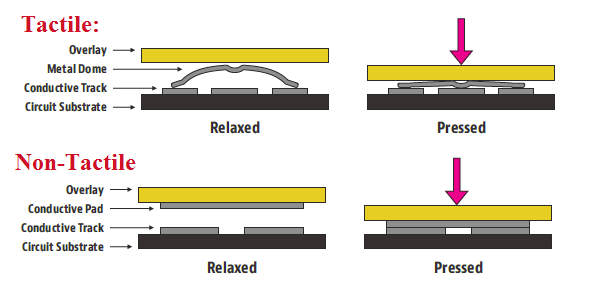What is the Basic Difference Between Tactile and Non-tactile Membrane Switches?
After membrane switches and keypads were invented, they weren’t trusted to be the best quality method of inputting data. Though with the passing time membrane keypads and switches have had a huge transformation in their perceived image and have stood positively to the test of time. Now they are proven to be one of the best cost-effective and reliable input methods for many different applications. Due to the unquestionable benefits and advantages, these high technology subsystems have become irreplaceable to many industries. Mainly two types of membrane switches are used in the market, classified into tactile membrane switches, and non-tactile membrane switches. These switches can also be used by mixing and matching according to their functionality in the very same panel. A printed circuit board can be opted to use for the lower circuit to provide structural support in addition. These switches play an equally important role in modern technology, though they are different in many ways, the functionality, construction, and uses of these tactile and nontactile membrane switches are different in minimalistic yet significant ways.’ How exactly tactile and non-tactile membrane switches are different if the differences are minute?’ Let’s discuss that in detail.
Construction of Tactile and Non-tactile Membrane Switches:
The construction is almost the same as the tactile and the non-tactile membrane switch. In the construction of the tactile membrane switch, there is a metal dome just below the surface of the overlay. Whereas in non-tactile membrane switch there is a conductive pad instead of a metal dome, again just below the overlay layer.
With the tactile membrane switch, the user gets tangible feedback when the button has been pressed. The metal dome once pressed provides momentary contact with the circuit layer. It is supported by the adhesive spacer layer and in the relaxed state, the dome legs rest on the outer rim of the primary pathway. When pressed, the dome makes contact with the secondary pathway right in the center, thereby completing the loop of the circuit. Materials like stainless steel, polydome or hydroform can be used to make these switches, in addition, it can be activated more than a million times.
While with the non-tactile membrane switch, separate feedback to the user is used to confirm activation. The activation can be done with light, sound or visual display. Non-tactile membrane switches are comparatively more reliable and have a high durability stand. It can be activated up to five million times in its life cycle.
The Functionality of the Tactile and Non-tactile Membrane Switches:
Tactile membrane switches are usually internally vented and are sealed from the environment surrounding it. This makes it stronger against contamination from outside particles making it useful for the medical industry. The tactile membrane switches is a momentary switch. Its construction defines its functionality. The significance of the construction is when it is pressed, the action is set into a flow and when the pressure is released the action flow stops. Its use can be easily understood through the example of keyboard switches, out of many of its functionalities. In the case of keyboard switches when the letter or symbol is pressed the action is inflow and the letter or symbol appears on the screen. And when the pressure is released the letter or symbol stops appearing as the action is stopped.
Non-tactile membrane switches are used to activate objects like backlighting of the control board monitor. When the button is pressed nothing appears on the monitor screen, instead an LED light will turn on or a beeping sound will occur to indicate that the activation has been done. These are just a few examples, elaborating one of the functions of these membrane switches out of many functions.
Uses of Tactile and Non-tactile Membrane Switches:
Tactile switches are sealed and usually vented internally making them preventive to outside particles in the surrounding environment. Due to this quality, it has been widely adopted by the medical industry. These switches carry out a small number of functions, are easily integrated with portable devices and have optimal visibility, additionally, lightweightedness adds to its value for medical industry devices. Throughout the medical facilities, these devices are used like hospital bed controls, ultrasound systems, monitoring equipment, thermostats and many more. These switches are vulnerable to bacterial attacks or cleaning products, making it essential for the use of materials that can be resistant to these infectants, making them ideal for healthcare or medical facilities. Non Tactile membrane switches are whole self-accommodated units that do not provide feedback. Often supported by audio signal or visual display to ease out the use for the operator. Most commonly seen in microwaves, these switches give a beeping sound to indicate that action has been activated. It allows keypad shaping and sizing customization which makes it most preferable for designers and engineers in general. The transport industry hugely uses non-tactile membrane switches at gas stations and vehicle speedometers. Speedometers do not require any tactile input but need to constantly show the levels of speed as the user drives the vehicle. These switches are customized with embossing and backlighting function to provide more clarity to the rider. These are user-friendly and cost-effective designs.
Be it tactile or non-tactile membrane switches both have their significant roles in technology today. Widely used in many industries, they have been proven to be highly customizable subsystems for the evolving technology. Each one comes with its own set of pros and cons, it depends upon the manufacturer the usability of the switches and with that its application. Though we can state this with the assurance that both membrane switches are in technology for a long haul.



Recent Comments